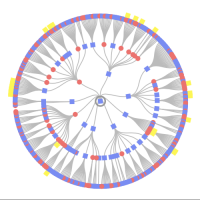Place names, None of the above

Please change this instruction: "If the standardized place is wrong or blank, select a standard that best matches the place you entered."
The instruction as currently worded is at best misleading. What is a "best match"? That is much too subjective.
If no defined standard is correct, the contributor probably should be instructed not to just pick a "best" wrong standard, but to choose "None of the above" at the very bottom of the menu. And perhaps once that is chosen, the display message should reflect that choice, repeating "None of the above". All other selections are echoed in the display.
Comments
-
The new interface has no instructions that I can find.
"None of the above" means that no standard has been chosen, and that's what the display shows. This makes sense to me, as there is nothing "above" that field when you're just looking at it.
There is always a way to get a correct standard. It may just be the country, if your information is sufficiently vague. And getting the display to be different from the standard has been made exceedingly difficult in the new interface. It is still possible, but I always end up trying so many different ways that I don't remember which way was the one that worked.
1 -
When in doubt I sometimes use just the country, for instance when historical records say Louisiana or Texas. But what I am after here is a selection that could convey to the gazetteer team there is no suitable standard for this place.
2 -
I've been trying to come with better instructions for days that are short but clear and must say I am understanding the struggle the designers must have had to come up with what is here.
"If the standardized place is wrong or blank, select a standard that best matches the place you entered" has as its first problem that the standard field is never blank. So this should say "If the standardized place is wrong or contains 'No Standard Is Selected,' select a standard that best matches the place you entered."
It also does not state how to select a standard so maybe should say, ""If the standardized place is wrong or contains 'No Standard Is Selected,' click in the Standardized Event Place field to select a standard that best matches the place you entered."
Occasionally when entering in a full place name and choosing that name from the top line of the drop down menu, the default of setting the standard to the second line in the menu will be wrong and you have to click on the default standard to open its dropdown menu to select a different standard:
(This is a rather artificial example because I did not enter the full place name. I couldn't think of an occasion I have had recently when the default was incorrect.)
The "best standard" would be the correct one or a standard that is one place level up. But how do you explain that in just a few words?
"Closest standard" would imply the next town over would be OK which is not the case.
"Select a standard that is the place you entered or is the next higher jurisdiction for that place" is getting a bit long and I'm not sure that is any clearer.
"Select a standard that is the place you entered or is a higher jurisdiction for that place" to cover that sometimes all you can put as the standard is the country is even more confusing.
"Select a standardized event place name that is a variant name of the accurate, full place name you entered or that is the next higher level of the place name you entered. For example, for 'Tveito, Eidfjord, Hordaland, Norway' you may need to enter as the standardized event place name 'Tveit, Eidfjord, Hordaland, Norway' if that is another name for the same place or 'Eidfjord, Hordaland, Norway' or "Hordaland, Norway' or "Norway' if there are no correct choices for the accurate, full place name you entered" might be clearer, but way too long.
What does anyone reading this post think would work to explain in as few of words as possible how to link the correct standardized event place name to a complete, correct place name that does not have an exactly matching standardized version for it?
3 -
@Gordon Collett How about, "If the first level place name does not appear in the Standardized list - please consider adding the place [Edit to add per @Julia Szent-Györgyi : suggestion] to our place names database"?
There needs to be some way of getting people to recognize when they need to add place [Edit to add per @Julia Szent-Györgyi : suggestions].
1 -
Well, I don't know what a "first level place name" might be.
0 -
I think it's listed first. city/town, county, state, country are common in USA - so first level would mean city/town. Of course other countries could have different divisions or possibly arrangements - so first to them may mean something else or in a different order/placement - so maybe if the person is registered/connecting from that country - that arrangement should be used...
In the Indexing app - there are instructions for a United States project which state:
Separate geographical levels of locality, from smallest to largest, with a comma.
So maybe that would be a good wording to use...
0 -
What would you use as a general term for the sections of a place name that is completely unambiguous and would be universally understood?
First ?, Second ?, Third ?, ...., Sixth ?, ......, Final ? (which would usually be the country).
0 -
I think maybe just use the wording above and then give the example of - city/town, county, state, country - or whatever levels correspond to the country being referenced. I would not think numbering them would be of great help - but a relevant generic example probably would. So this suggestion would possibly involve different templates for each country ...
0 -
The trouble is, it would depend on the name being entered.
If you are requesting a municipality be entered, the name of the municipality is the first level, then county the second level, and the country the third level.
If you are requesting a town within a municipality be entered, then the first level is the town name and all the others are moved up a level. Likewise if you are requesting a section within the town, that section is now the first level place name. That is why "if the first level place name...." would work, but if "level" is not meaningful, another term is needed.
0 -
That is why I think there should also be an example (or the generic structure) - that makes clearer what name/structure is being requested. The fact that most places can be listed with several different structures does not mean that users cannot just select one or follow an example given. I think most users will just select the structure that is most familiar to themselves - and that should be perfectly acceptable and an identifiable location.
1 -
@genthusiast wrote: "so maybe if the person is registered/connecting from that country"
Um, no. The location of the user has absolutely no relevance to the question: I enter places from the country I live in exactly zero percent of the time. In fact, over 90% of the time, I'm entering jurisdictions that haven't existed in well over a century.
The problem with "please consider adding the place to our place names database" is that it implies that users can add to the database -- but we can't. We can merely suggest additions.
Another problem with suggesting that people try to add to the database is that a lot of times, the place is already in the database. Sometimes it has errors -- it's connected to the wrong parent place, or it's under a little-used variant name, or the language abbreviation is wrong, or something. In any case, it's all too complicated for a layperson to easily sort. One reason for this is the difference between ecclesiastic and political jurisdictions. Especially for places now in Germany, the current database is full of confusing mishmashes of the two. It's especially bad when the jurisdictions have changed -- they redrew the counties, or combined parishes, or established new countries ....
I think the difficulty in coming up with instructions that are short but easily understood is the reason that the new interface skips them entirely. Perhaps what is needed is an offer of a link to somewhat longer, illustrated instructions: "Click Here for an explanation of standardizing placenames" (or something like that). Then the instructions could have examples: "If none of the options look correct, you may need to associate the location with a higher jurisdiction. For example, if 'Marshallton, West Bradford, Chester, Pennsylvania, United States' is not on the list, you can use 'West Bradford, Chester, Pennsylvania, United States' instead." Then add something about suggesting additions to the database, but with some sort of explanation that you don't need to add every family graveyard and named meadow.
1 -
You are correct. I did use 'consider adding the place' incorrectly - it should be 'consider adding a place suggestion [to the queue]'. [See edits above - thanks to Julia!] Users adding place suggestions that result in places being added are 'FamilySearch adding places' - for those rejected by FamilySearch they were just suggestions.
The location of the user has absolutely no relevance to the question:
This is your opinion. In my opinion natives that live - and their family that may have lived closest to places for a long period of time - matter much - as they may have a broader knowledge of those places. Also in presentation of places it matters - as mentioned above ...
In any case, it's all too complicated for a layperson to easily sort.
Good point - that's probably why there hasn't been more progress on places - people aren't willing to take the time to understand. Which goes back to @Gordon Collett point on places (and my point briefly above) - people are familiar with places on their own terms/structures - so having place be different from Standardized place should be understood and perfectly acceptable. Yes changing place names from timeframes/jurisdictions does make it more complicated. But it's not because it's too complicated - it's more like - not easy or takes too much time - and not one person can be expert ...
I entirely agree with you that perhaps the better approach will be to provide illustrated instruction/educational video about the place names database/authority/standard (whatever you want to call it). I also agree that @dontiknowyou Idea in this thread is a good way to get more suggestions to the 'gazeteer team' (upvoted) - any such selection could trigger a place suggestion (bring up the remainder of the form for the suggestion to be completed).
0 -
Since this conversation has shifted over to taking about getting place names added to the Places database, @Julia Szent-Györgyi and @genthusiast , I'm going to jump over to @dontiknowyou 's other suggestion to fix the information icon notice at: https://community.familysearch.org/en/discussion/134200/place-names-none-of-the-above-2
0



